Citroën
 | |
| Type | Subsidiary of PSA Peugeot Citroën |
|---|---|
| Industry | Automotive |
| Founded | 1919 |
| Founder(s) | André Citroën |
| Headquarters | Saint-Ouen, Seine-Saint-Denis,France[1] |
| Key people | Frédéric Saint Geours (Director of Autombiles Citroën) |
| Products | Automobiles |
| Production output | 1,435,688 (2011) |
| Employees | 13,900[2] |
| Parent | PSA Peugeot Citroën |
| Website | Citroën.com |

1940s Citroën in Vaxholm, Sweden 2012
Citroën (French pronunciation: [si.tʁɔ.ˈɛn]) is a majorFrench automobile manufacturer, part of the PSA Peugeot Citroëngroup.
Founded in 1919 by French industrialist André-Gustave Citroën (1878–1935), Citroën was the first mass-production car company outside the USA [3] and pioneered the modern concept of creating a sales and services network that complements the motor car.[4] Within eight years Citroën had become Europe’s largest car manufacturer and the 4th largest in the world.[5]
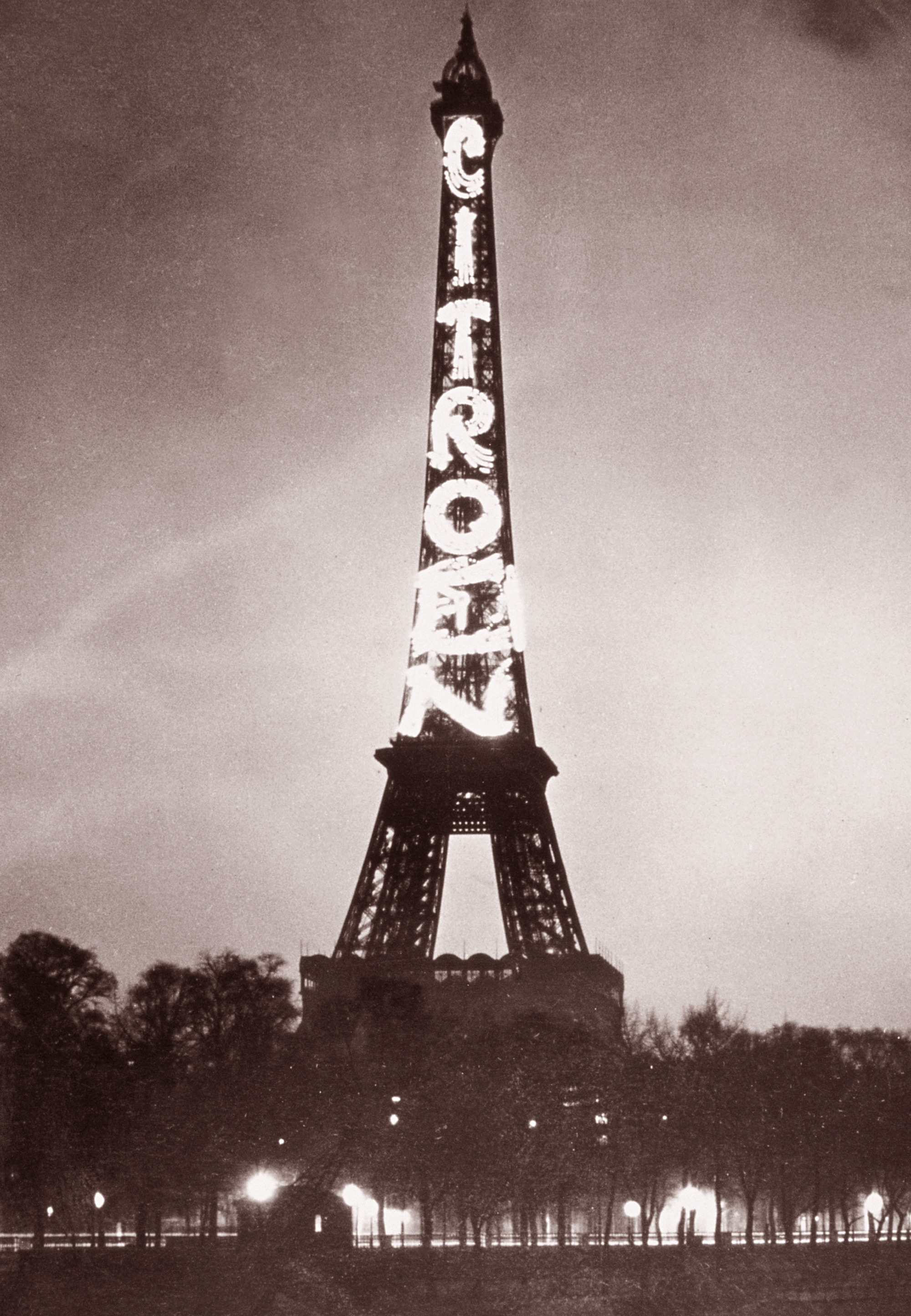
The Eiffel Tower served as a billboard for Citroën from 1925 to 1934.
Citroën earned a reputation for innovation and revolutionary engineering, which is reflected in the company’s slogan “Créative Technologie”. Its history of innovation began with its founding, when André-Gustave Citroën introduced the first industrial mass production of vehicles outside the United States, a technique he developed while mass-producing armaments for the French military in World War I. In 1924, Citroën produced Europe’s first all-steel-bodied car, the B-10.[6] In 1934, Citroën secured its reputation for innovation with its Traction Avant, not only the world’s first mass-produced front-wheel drive car, but also one of the first cars to feature a monocoque-type body.[7]In 1954 Citroën produced the world’s firsthydropneumatic self-levelling suspensionsystem,[citation needed] then in 1955 the revolutionary Citroën DS, the first European production car with disc brakes.[citation needed] In 1967, Citroën introduced the first swiveling headlights in several models, allowing for greater visibility on winding roads.
The brand celebrated its 90th Anniversary in 2009.
Contents[hide]
|
[edit]History
[edit]Early years

André Citroën
André Citroën built armaments for France during World War I; after the war, however, he had a factory without a product. In 1919, the business started to produce automobiles, beginning with the conventional Type A. The Type A was designed by Jules Salomon, Chief Design Officer from Le Zèbre.
That same year, André Citroën briefly negotiated with General Motors on a proposed sale of the Citroën company to GM.[8] The deal nearly closed, but GM ultimately decided that its management and capital would be too overstretched by the takeover.[8] Citroën thus remained independent for many years to come.
Citroën was a keen marketer—he used theEiffel Tower as the world’s largest advertising sign, as recorded in the Guinness Book of Records.[9] He also sponsored expeditions in Asia (Croisière Jaune) and Africa (Croisière Noire), intended to demonstrate the potential for motor vehicles equipped with the Kégresse track system to cross inhospitable regions. The expeditions conveyed scientists and journalists.
Demonstrating extraordinary toughness, a 1923 Citroën that had already travelled 48,000 km was the first car to be driven around Australia. The car, a 1923 Citroën 5CV Type C Torpedo, was driven by Neville Westwood fromPerth, Western Australia on a round trip from August to December 1925. The car is now fully restored and in the collection of the National Museum of Australia.[10]
In 1924, Citroën began a business relationship with American engineer Edward G. Budd. From 1899, Budd had worked to develop stainless steel bodies for railroad cars, for the Pullman in particular. Budd went on to manufacture steel bodies for many automakers, Dodge being his first big auto client. At the Paris Motor Show in October 1924, Citroën introduced the Citroën B10, the first all-steel body in Europe.[6]
The cars were initially successful in the marketplace, but soon competitors (who were still using a wooden structure for their bodies), introduced new body designs. Citroën did not redesign the bodies of his cars. Citroëns still sold in large quantities in spite of not changing the body design, but the car’s low price was the main selling point and Citroën experienced heavy losses.[citation needed]
In an attempt to remedy the situation, Citroën developed the Traction Avant. The Traction Avant had three revolutionary features: a unitary body with no separate frame, front wheel independent suspension, and front wheel drive. Citroën commissioned Budd to create a prototype, which evolved into the 7 horsepower (CV), 32 hp (24 kW) Traction Avant of 1934.
In 1933, Citroën also introduced the Rosalie, the first commercially available passenger car with a diesel engine, developed with Harry Ricardo.
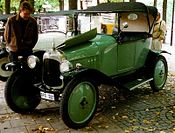



[edit]Michelin era

Pierre-Jules Boulanger
Achieving quick development of the Traction Avant and its production facilities at the same time was too costly and overly ambitious, causing the financial ruin of the company. In December 1934, despite the assistance of the Michelin company, Citroën filed for bankruptcy. Within the month, Michelin, already the car manufacturer’s largest creditor, became in addition its principal shareholder. Fortunately for Michelin, the technologically advancedTraction Avant met with market acceptance, and the basic philosophy that had led to this design continued. Pierre Michelin became the chairman of Citroën. Pierre-Jules Boulanger became the vice-president of Citroën and chief of the Engineering and Design department. In 1935 André Citroën died from stomach cancer.
Pierre-Jules Boulanger had been a First World War air reconnaissance photography specialist with the French airforce. He was capable and effective, and finished the war having risen to the rank of captain. He was also courageous, decorated with the Military Cross and the Legion of Honour. He started working for Michelin in 1918, reporting directly to Édouard Michelin, co-director and founder of the business. Boulanger joined the Michelin board in 1922. He became president of Citroën in 1937 after the death of his friend and kept his position until his death in 1950. In 1938, he also became Michelin’s joint managing director.
During the German occupation of France in World War II Boulanger refused to meet Dr. Ferdinand Porsche or communicate with the German authorities except through intermediaries. He organised a “go slow” of production of trucks for the Wehrmacht, many of which were sabotaged at the factory, by putting the notch on the oil dipstick in the wrong place, resulting in engine seizure. In 1944 when the Gestapo headquarters in Paris was sacked by the French Resistance, his name was prominent on a Nazi blacklist of the most important “Enemies of the Reich” to be arrested in the event of an allied invasion of France.[11]
Citroën researchers continued their work in secret, against the express orders of the Germans, and developed the concepts that were later brought to market in the 2CV and DS. These were widely regarded by contemporary journalists asavant garde, even radical, solutions to automotive design. This began a period of unusual brand loyalty, normally seen in the automobile industry only in niche brands, like Porsche and Ferrari. The cult-like appeal of the cars to Citroënistestook almost two decades to fade, from 1975 to about 1995.[citation needed]
Citroën was undercapitalised, so its vehicles had a tendency of being underdeveloped at launch, with limited distribution and service networks. For both the important DS and CX models, development of the original engine around which the design was planned proved too expensive for the finances available, and the actual engine used in both cases was a modest and outdated four-cylinder design.
Citroën unveiled the 2CV (2 fiscal horsepower, initially only 12 HP) at the Paris Salon in 1948. The car became a bestseller, achieving the designer’s aim of providing rural French people with a motorized alternative to the horse. This car remained in production, with only minor changes, until 1990 and was a common sight on French roads until recently.
1955 saw the introduction of the DS, the first full usage of Citroën’s now legendary hydropneumatic self-levelling suspension system that was tested on the rear suspension of the last of the Tractions. The DS was the first European production car with disc brakes.
The DS featured power steering, power brakes and power suspension, and—from 1968—directional headlights. A single high-pressure system was used to activate pistons in the gearbox cover to shift the gears in the transmission and to operate the clutch on the Citromatic, Citroën’s semi-automatic transmission.
This high-pressure hydraulic system would form the basis of many Citroën cars, including the SM, GS, CX, BX, XM, Xantia, C5 and C6. These vehicles shared the distinguishing feature of rising to operating ride height when the engine was turned on, like a “mechanical camel” (per Car & Driver magazine). A lever beside the driver’s seat allowed the driver to adjust the height of the car, this has now been replaced by an electronic switch. The height-adjustability of the suspension allows for clearing obstacles, fording shallow (slow-moving) streams, and changing tires. This type of suspension is uniquely able to absorb road irregularities without disturbing the occupants.
During Citroën’s venture with Maserati, the Citroën high-pressure hydraulic system was used on several Maserati models, for power clutch operation (Bora), power pedal adjustment (Bora), pop-up headlights (Bora, Merak), brakes (Bora, Merak, Khamsin), steering (Khamsin), and the entire Quattroporte IIprototype, which was a four-door Citroën SM under the skin.
Citroën was one of the early pioneers of the now widespread trend ofaerodynamic automobile design, which helps to reduce fuel consumption and improve high-speed performance by reducing wind resistance. The firm began using a wind tunnel in the 1950s, enabling them to create highly streamlined cars such as the DS which were years ahead of their time. So good were the aerodynamics of the CX, that it took its name from the term used to measure drag coeffient –  .
.
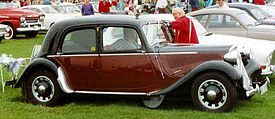



[edit]Financial restructuring
In 1963, Citroën negotiated with Peugeot to cooperate in the purchase of raw materials and equipment. Talks were broken off in 1965.
That year Citroën took over the French carmaker Panhard in the hope of using Panhard’s expertise in midsize cars to complement its own range of very small, cheap cars (e.g., 2CV/Ami) and large, expensive cars (e.g., DS/ID). Cooperation between both companies had begun 12 years earlier, and they had agreed to a partial merger of their sales networks in 1953. Panhard ceased making vehicles in 1967.
1968 saw a restructuring of Citroën’s worldwide operations under a new holding company, Citroën SA. Michelin, Citroën’s long-time controlling shareholder, sold a 49% stake to Fiat, in what was referred to as the PARDEVI agreement (Participation et Développement Industriels).
That year Citroën purchased the Italian sports car maker Maserati and launched the grand tourer SM, which featured a V6 Maserati engine and a fully powered steering system called DIRAVI. The SM was engineered as if it were replacing the DS, a level of investment the GT sector alone would never be able to support, even in the best of circumstances. Circumstances became more unfavorable as the 1970s progressed. Citroën suffered another financial blow in the 1973 energy crisis. In 1974, the carmaker withdrew from North America, due to design regulations that outlawed core features of Citroën cars.
Huge losses at Citroën were caused by failure of the Comotor rotary engine venture, plus the strategic error of going the 15 years from 1955 to 1970 without a model in the profitable middle range of the European market, and the massive development costs for the GS, CX, SM, Maserati Bora, Maserati Merak, andMaserati Khamsin models—each a technological marvel in its own right.


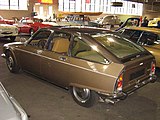

[edit]PSA era
| This article may contain original research.Please improve it by verifying the claims made and adding references. Statements consisting only of original research may be removed.(September 2009) |
Citroën was weak and unable to withstand the softening of the automobile market that accompanied the 1973 oil crisis. That year Fiat withdrew from PARDEVI and returned its 49% stake to Michelin. This was an ominous sign of things to come and, less than a year later, Citroën went bankrupt. The French government feared large job losses and arranged talks between Michelin andPeugeot, in which it was decided to merge Automobiles Citroën and Automobiles Peugeot into a single company. In 1974, Peugeot purchased 38.2% of Citroën and became responsible for managing the combined activities, in particular their research, purchasing, and investments departments.
Peugeot sold off Maserati to De Tomaso in May 1975, and the Italian firm was quickly able to exploit the image of the Maserati brand to sell tens of thousands of newly designed Bi-Turbo models.
The takeover was completed in May 1976, as Peugeot SA purchased a 90% stake of Citroën SA and the companies were combined into a holding company, known as PSA Peugeot Citroën.
The PSA venture was a financial success from 1976 to 1979. Citroën had two successful new designs in the market at this time (the GS and CX), a resurgentCitroën 2CV, and the Citroën Dyane in the wake of the oil crisis, and Peugeotwas typically prudent in its own finances, launching the Peugeot 104 basedCitroën Visa and Citroën LNA. PSA then purchased the aging assets of Chrysler Europe, which it rebranded as Talbot, leading to losses from 1980 to 1985.
PSA gradually diluted Citroën’s ambitious attitude to engineering and styling in an effort to rebrand the marque to appeal to a wider market. In the 1980s, Citroën models became increasingly Peugeot-based, following the worldwide motor industry trend called “platform sharing.” The 1982 BX used thehydropneumatic suspension system and still had a Citroënesque appearance, while being powered by Peugeot-derived engines and using the floorpan later seen on the Peugeot 405. By the late 1980s, many of the distinctive features of the marque had been removed or diluted – conventional Peugeot switchgear replaced Citroën’s quirky but ergonomic “Lunule” designs,[12] complete with self cancelling indicators that Citroën had previously refused to adopt on ergonomic grounds.
Citroën expanded into many new geographic markets. In the late 1970s, the firm developed a small car for production in Romania known as the Oltcit, which it sold in Western Europe as the Citroën Axel. Sales were adversely affected by poor build quality. That joint venture has ended, but a new one between PSA and Toyota is now producing cars like the Citroën C1 in the Czech Republic.
In China, Citroën began selling cars in 1984, and currently builds a range of family cars including the C3 and Xsara and locally designed cars like the Fukangand Elysée models. Citroën is a global brand except in North America, where the company has not returned since the SM was effectively banned in 1974 for not meeting U.S. National Highway Traffic Safety Administration (NHTSA) bumper regulations.
Production of the 2CV ended in 1990. More recently, Citroën has introduced theC3 Pluriel, an unusual convertible with strong allusions to the 2CV, both in body style (such as the bonnet) and in its all-round practicality.

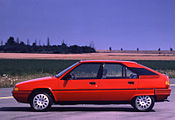


Citroën subsequently announced that it was setting up a premium series of cars under the DS name that would run parallel alongside its current car range. The DS range was launched early in 2010 with the DS3, a premium small car based on the floor plan of the new C3. The DS3 was followed by the larger DS4 and the large DS5 respectively. Their rear badge is a new DS logo rather than the familiar Citroën double chevron and all will have markedly different styling from their equivalent sister car.[13][14]
Worldwide sales of vehicles reduced from 1,460,373 in 2010 to 1,435,688 in 2011, with 961,156 of these sold in Europe.[15]





[edit]Logo
Logo used from 1985 until 2009
The origin of the logo may be traced back to a trip made to Łódźcity, Poland by the 22-year-old André Citroën, where he discovered an innovative design for a chevron-shaped gear used inmilling. He bought the patent for its application in steel. Mechanically a gear with helical teeth produces an axial force. By adding a second helical gear in opposition this force is cancelled. The two chevrons of the logo represent the intermeshing contact of the two.[16]
The presentation of the logo has evolved over time. Before the war, it was rendered in yellow on a blue background. After the war, the chevrons became more subtle herringbones, usually on a white background. With the company searching for a new image during the 1980s, the logo became white on red to give an impression of dynamism, emphasized by publicity slogan.
In February 2009 Citroën launched a new brand identity to celebrate its 90th Anniversary, replacing the 1985 design. This consisted of the new logo, designed by Landor Associates[17] — a 3D metallic variation of the double chevron logo accompanied by a new font for the Citroën name and the new slogan “Créative Technologie”. A TV campaign reminiscing over 90 years of Citroën was commissioned to announce the new identity to the public.[18] The new look is currently being rolled out to dealers globally and is expected to take three to five years.
[edit]Citroën Racing
Citroën Racing, previously known as Citroën Sport, is the team responsible for Citroën’s sporting activities. They are a winning competitor in the World Rally Championship. After an abortive attempt with the Group B Citroën BX 4TC in1986, the team returned with the Citroën ZX Rally Raid to win the Rally RaidManufacturer’s Championship in 1993, 1994, 1995, 1996, and 1997 with Pierre Lartigue and Ari Vatanen. They won the Dakar Rally in 1991, 1994, 1995, and 1996.
From 2001 the team started participating in the World Rally Championship, winning the Manufacturer’s Title in 2003, 2004, 2005, 2008, 2009, 2010 and2011. In 2004, 2005, and 2006, French driver Sébastien Loeb won the Drivers’ Championship driving the Citroën Xsara WRC, in 2007, 2008, 2009 and 2010 with the Citroën C4 WRC, and in 2011 with the Citroën DS3 WRC.
[edit]Awards
[edit]European Car of the Year awards
- 1971: Citroën GS
- 1975: Citroën CX
- 1990: Citroën XM
Several models were shortlisted including the 1971 Citroën SM, 1988 AX, 1994Xantia, 2003 C3, 2005 C4 and 2007 Citroën Grand C4 Picasso.
[edit]USA Car of the Year award
- 1972 Citroën SM Motor Trend Car of the Year
[edit]See also
| Paris portal | |
| Companies portal |
- List of Citroën vehicles
- List of French companies
- Lane departure warning system
- Citroën World Rally Team
[edit]References
- Notes
- ^ “Saint-Ouen retrouve son fleuve, la Seine.” l’Humanité. 28 October 2006. Retrieved on 3 February 2010. “La mort lente des petites entreprises, la délocalisation des plus importantes ont transformé Saint-Ouen. Il ne reste en centre-ville que l’usine Citroën..”
- ^“The Company”. citroen.com. Retrieved 2007-09-19.
- ^“NSN”.
- ^“Citroënmania.com”.
- ^ Reynolds, John. “André Citroën: Engineer, Explorer, Entrepreneur”. (J H Haynes & Co Ltd) Revised edition (25 August 2006) Page 63
- ^ ab“Citroën – All-Steel Bodywork”.
- ^ Reynolds, John. “André Citroën: Engineer, Explorer, Entrepreneur”. (J H Haynes & Co Ltd) Revised edition (25 August 2006) inside cover
- ^ abSloan, Alfred P. (1964), McDonald, John, ed., My Years with General Motors, Garden City, NY, USA: Doubleday, LCCN64011306,OCLC802024. Republished in 1990 with a new introduction by Peter Drucker(ISBN 978-0385042352)., p. 317.
- ^“European Motor News”.
- ^“1923 5CV Citroen, National Museum of Australia”. Nma.gov.au. Retrieved 2011-08-01.
- ^ John Reynolds. Citroën 2CV. ISBN978-1-84425-207-7.
- ^“Citroënët – Lunule Switchgear”.
- ^“Citroen DS returns | Auto Express News | News”. Auto Express. 2009-02-06. Retrieved 2009-09-17.
- ^“Site officiel de la CITROËN DS3”. Ds3.citroen.com. Retrieved 2009-09-17.
- ^“Annual Report Presentation 2011”. PSA Peugeot Citroen. Retrieved 27 June 2012.
- ^“Citroën Logo: Design and History”. FamousLogos.us. Retrieved 2011-08-19.
- ^/ Communicate magazine / Communicate magazine, June 2009
- ^“90 Years Citroën TV Ad (Youtube Video)”.
From Wikipedia, the free encyclopedia